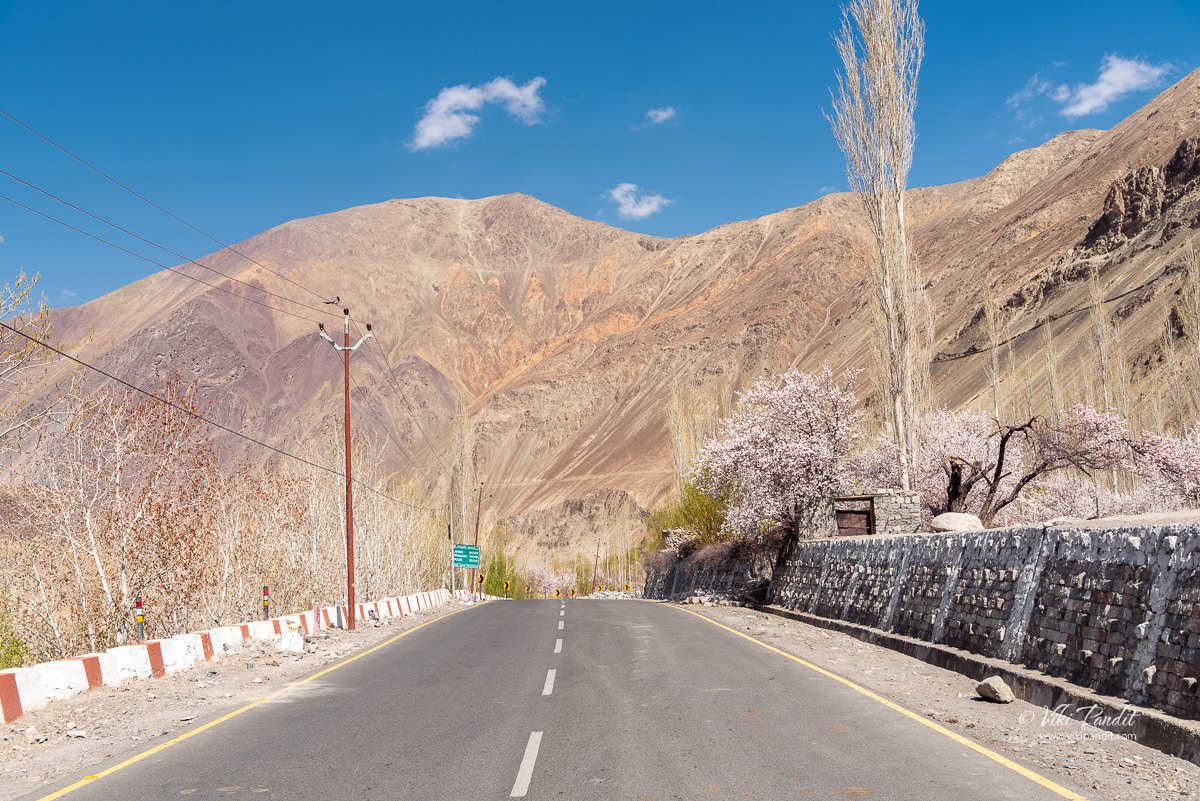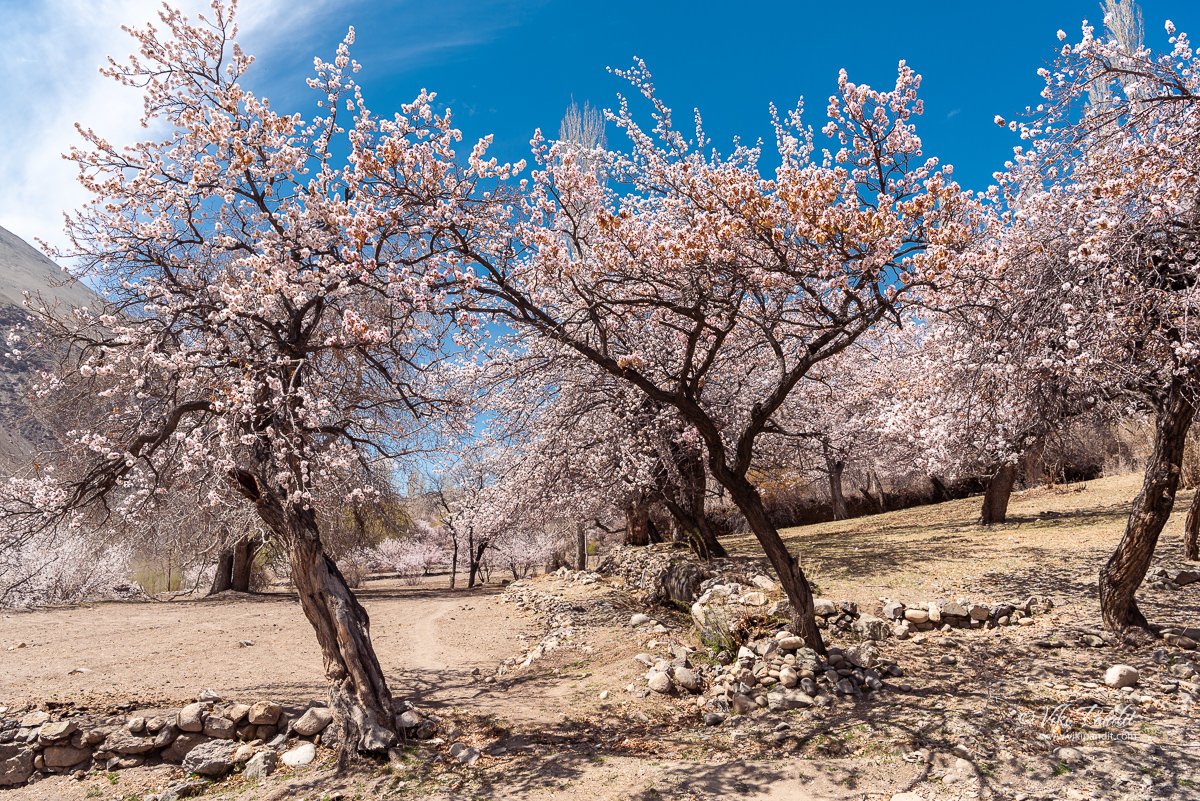Ladakh is a magical place known for its gorgeous mountains, crystal-clear lakes, and rich cultural traditions. This is my second visit to the land of passes. This time Mani and I came a month early to capture the Apricot Blossom Festival in Ladakh that celebrates the region’s natural beauty and cultural heritage. The festival takes place in April when the trees start blooming, covering the hills and valleys in a blanket of pink and white.
Very less people know that they also host the Apricot Blossom Festival. You might have heard of Japan’s Cherry Blossom Festival, but what about the apricot one in Ladakh? Apricot was first introduced when Ladakh was a famous Silk route and this event was organized to celebrate such exclusive beauty of nature. Organized across various places in Ladakh, the festival is held in collaboration with the local communities to make tourism more eco-friendly and to find ways for local people to benefit from the event.
Apricot blooms refer to the beautiful and delicate flowers that blossom on apricot trees during the spring season. These blooms are known for their pale pink to white petals and are a stunning sight when they blanket apricot orchards in a sea of soft colors. Apricot trees typically produce these blossoms before they bear fruit, making them a welcome sign of the changing seasons and the promise of a fruitful harvest to come. Enjoying apricot blooms in Ladakh is a delightful experience, as the region’s landscape is transformed into a sea of pink and white during the blooming season.
Apricots, called “Chuli/Halmann” in Ladakhi, were brought to the dry area of Ladakh by Chinese traders who passed through the area along the Silk Road more than a hundred years ago. Now, in the 21st century, the fruit is an integral part of Ladakh’s culture, history, and economy. Due to its cold climate, Ladakh is a great place to grow apricots and apples.
Apricot trees thrive in cooler climates, with an average maximum temperature of 18-19 degrees Celsius during the crop-growing season. These trees go dormant during severe winters and bloom in the spring. Another vital climatic factor is aridity, as drier conditions lead to higher-quality apricots.
It usually takes five to six years for the fruiting of the apricot plant. Typically, the fruit ripens in Ladakh in July, August and September. The productive life of an apricot tree is 80-100 years. So, while it takes five years for the fruit to come, you will get quality fruits on an apricot tree for a long time. On average, a tree produces about 30-50 kg of apricots every year.
The flowering of apricot trees is not only visually pleasing but also plays a crucial role in the pollination process, as it attracts bees and other pollinators, ensuring the development of apricot fruit. Apricot blooms are celebrated in various cultures and have even inspired festivals in regions where apricot cultivation is prominent.
The event celebrates the delicate pink flowers which come into full bloom throughout Ladakh’s two districts – Leh and Kargil. The flowers, just like the Japanese Sakura, do not last long and thus attract huge numbers of tourists when they bloom.
Vibrant cultural programmes, local handicraft stalls and Ladakhi food are generally part of this festival. Visitors are also able to enjoy locally produced items such as apricot jam, dried apricots, apricot wine, and other products made using the fruit.
This year’s festival, the theme of which is Chuli Mentok 2023, offers visitors the chance to stock up on locally made goods, including apricot jellies, dried fruit, juices, and even wine. The festival includes various activities, such as traditional music and dance performances, local food and craft exhibitions, and guided tours of the apricot orchards. The festival is also a great place to buy handicrafts made in the area, which is always a fun part of the Apricot Blossom Festival.
Researchers have also found that the sweetness of apricots increases with the rise in altitude.
If you are fond of apricot you might also know about apricot blossom flower from which blooms the apricot. The season for apricot blossom flower in Ladakh is from the beginning of April till May. Apricot blossom has the charisma to catch the attention of your eyes.
By the month of July – September they start producing yellow, orange rounded or oval-shaped apricot fruits. The oil extracted from the Raktsey Karpo seed is used for edible purposes either in pure form or mixed with walnut oil. A spoonful of oil is mixed with finely ground roasted barley flour, salted tea, and sugar to prepare a local dish called Phemar which is served during festive occasions.
There are varieties of apricots grown in Ladakh that differ from one another in taste (sweet, bitter and sour) and that also differ in size. The varieties include Halman, Laktse-Karpo, Safaida and Khanteh etc. Halman and Laktse-Karpo are the most preferred ones for commercial purposes. Apricot products such as apricot juice, apricot jam, apricot etc. are made. The apricots are even exported in the international market as well as within India.
Both the fruit and kernel of apricot are believed to be highly nutritive and consumed as either fresh or dried. It has become an essential part of the traditional culture of people in Ladakh. Local people serve dry or fresh apricots as dessert. It also has health benefits.
Rakstep Karpo is a unique variant of Apricot that consuming only in Ladakh. That is why locals celebrate the day as Apricot Blossom Festival. The Ladakhi apricot Raktsey Karpo received its first-ever Geographical Indication (GI) in 2022. This highly sought-after GI tag accreditation is granted for 20 years. Along with nine other items, Raktsey Karpo Apricot has recently been registered in the GI tag lists. Despite growing more than thirty different varieties of apricots, the Raktsey Karpo variety is exclusive to the Ladakh region. This unique apricot type from Ladakh is unparalleled in flavour and vibrant with white Kernel. Raktsey Karpo variety is primarily concentrated in and around Sham, Leh, Nubra and Kargil.
We did not visit Nubra this time but I hear it is renowned for its apricot orchards. The entire valley is a sight to behold during the blooming season. Consider staying in a local homestay in a village like Diskit or Hunder. This not only provides an authentic experience but also allows you to be closer to the orchards.
Raktsey Karpo is also rich in sorbitol – a natural glucose substitute that can be consumed by diabetics. And that’s not all. The oil from its seed is known to relieve back aches and joint pain!
Ladakh is one of the most popular places for tourist destinations and tourists can also celebrate the festivals of Apricot blossom. As a part of the festival, visitors can enjoy the local cultural programs, and different exhibitions and experience apricot trees blossoming. Moreover, they can purchase the products of apricots as a souvenir.
Remember that Ladakh is a high-altitude region, so it’s important to acclimatize properly, stay hydrated, and take precautions for altitude sickness.
Thanks for reading. Please leave your comments if you enjoyed my story or follow me on my journey as we visit the Kargil War Memorial to pay respect at the memorial dedicated to the martyred soldiers.
When: April 4 to 17, 2023
Where: Lhardo (April 4), Saspol (April 5), Udmaroo (April 10), Garkone (April 8), Sumoor (April 11), Hardass/Shilichiy (April 16), Karkitchoo/Chanigound (April 17)











